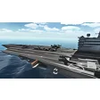Control a flight deck in Carrier Deck
Control a flight deck in Carrier Deck
Vote: (1 votes)
Program license: Paid
Version: 1.0
Works under: Windows
Vote:
Program license
(1 votes)
Paid
Version
1.0
Works under:
Windows
Pros
- Dynamic time management and strategy elements
- Realistic graphics enhance the gameplay experience
- Detailed progression system for lasting engagement
- Exciting, quick-paced missions linked into a larger campaign
Cons
- Camera and control systems may pose initially challenging
- Unforgiving difficulty curve may not appeal to all players
- No option to pause may overwhelm newcomers to the genre
Take Command of a Nautical Battlefield in Carrier Deck
Introduction to Carrier Deck
Carrier Deck thrusts players into the high-stakes world of military strategy and time management, setting them on the deck of the USS Ronald Reagan. As an officer, players must juggle a multitude of tasks, from launching aircraft for sorties to orchestrating the safe return of planes and managing incoming supplies, all the while responding to imminent threats.
Core Gameplay and Mechanics
The game is all about quick thinking and faster actions. At the heart of Carrier Deck's gameplay is a visual track representing different threats across air, land, surface, and sub-surface domains. The urgency to extend visibility range through reconnaissance missions adds a strategic layer to the frantic pace of managing an aircraft carrier.
Within the digital confines of the USS Ronald Reagan, players will navigate through the carrier's multiple decks, coordinating the crew and assigning the appropriate aircraft for each evolving scenario. The demand for meticulous attention and rapid decision-making means that even tasks that seem simple at face value can have complex and risky undertones.
Visual and Technical Aspects
The game presents itself with clear, realistic graphics that command attention. Each visual component is designed to contribute to the sense of urgency and concentration needed to effectively manage an aircraft carrier under the duress of combat. However, the camera movements can provide a challenge at times, perhaps contributing to the simulation's difficulty. Also, on-screen controls may require a level of precision that might not always feel intuitive, adding an additional challenge that some players may find frustrating.
User Interface and Controls
Navigating the user interface is a crucial aspect of mastering Carrier Deck. While initially daunting, the interface provides all the necessary information at a glance, which is essential for a game where split-second decisions can make the difference between victory and defeat. The learning curve for controls emphasizes the game's focus on skill and adaptability, ensuring a rewarding experience for those willing to overcome the initial hurdles.
Missions and Campaign Structure
Carrier Deck ensures that each mission is a bite-sized encounter, perfect for players seeking quick strategic bursts. However, it's the overarching campaign that strings these encounters together, creating a longer narrative that captures the tension and excitement of military operations. The progression system introduces new challenges and complexities, keeping players engaged and eager to see what comes next.
The Challenge of Time Management
If a player enjoys the pressures of time management woven into a complex military setting, Carrier Deck delivers on all fronts. The game does not feature a pause button, meaning the action is relentless, forcing players to constantly strategize on the move. It's this aspect that makes Carrier Deck not just a game of military strategy but also of profound time management skills.
Conclusion
Carrier Deck is a sophisticated blend of military simulation and time management gameplay. It offers a robust and challenging experience to those who enjoy high-stress, high-reward gaming sessions. The graphics, though occasionally tricky camera-wise, add to the realism of commanding a giant floating fortress, and the controls demand precision that mirrors the high standards of military operations.
Pros
- Dynamic time management and strategy elements
- Realistic graphics enhance the gameplay experience
- Detailed progression system for lasting engagement
- Exciting, quick-paced missions linked into a larger campaign
Cons
- Camera and control systems may pose initially challenging
- Unforgiving difficulty curve may not appeal to all players
- No option to pause may overwhelm newcomers to the genre




